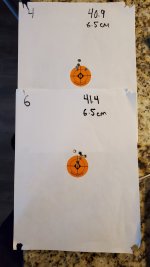I am currently working on a load for my Bergara HMR pro with the 139 gr lapua scenar in 6.5 CM. I am using hornady brass, all virgin up to this point now, federal 210M primers, and hodgdon 4350.
I started with a ladder test, starting at 40.0 grains of powder, working my way up by 0.2 grains at a time, as shown in the first picture.

The following picture shows the charge weights I shot, using the same seating depth of 2.310 to ogive. I was having issues with my labradar at this point, so that is why there is no data.

While I know the possibility of a low ES is because I don't have a full 5 shot group, I decided to go with 40.9 grains as my charge weight, and begin seating tests at 0.03 intervals.
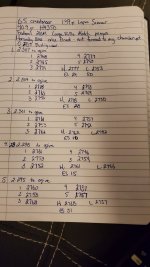
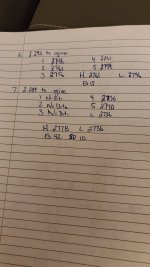
Since the charge weight is the same, yet I am seeing a different ES for each 5 shot group, is that just indicative of the actual ES for that charge weight over a large enough sample, or does it change because of seating depth and different pressures? If just going off speeds, group 3, at 2.301 to ogive is producing the best results. Group 5, at 2.295 to ogive produced the worst ES, yet produced the best looking group on paper.
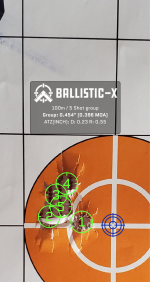
Group 3 was still promising, as the first shot felt good, but the sights did not end up even close to the point of aim after my follow through, so that could explain why that group is larger.
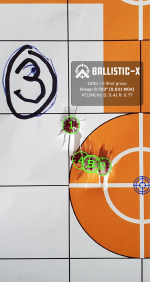
So, am I really just seeing a larger ES overall as a result of a larger sample (over 35 shots), or is this a result of changing pressures because of seating depth, and while that group I shot looks really good, it isn't an ideal ES. I could shoot both seating depths and take speeds again now that all the brass is fire formed, but I am hoping for a little knowledge that could save me from more testing that might not be necessary (Or is more testing at different charge weights what is really needed).
I started with a ladder test, starting at 40.0 grains of powder, working my way up by 0.2 grains at a time, as shown in the first picture.
The following picture shows the charge weights I shot, using the same seating depth of 2.310 to ogive. I was having issues with my labradar at this point, so that is why there is no data.
While I know the possibility of a low ES is because I don't have a full 5 shot group, I decided to go with 40.9 grains as my charge weight, and begin seating tests at 0.03 intervals.


Since the charge weight is the same, yet I am seeing a different ES for each 5 shot group, is that just indicative of the actual ES for that charge weight over a large enough sample, or does it change because of seating depth and different pressures? If just going off speeds, group 3, at 2.301 to ogive is producing the best results. Group 5, at 2.295 to ogive produced the worst ES, yet produced the best looking group on paper.

Group 3 was still promising, as the first shot felt good, but the sights did not end up even close to the point of aim after my follow through, so that could explain why that group is larger.

So, am I really just seeing a larger ES overall as a result of a larger sample (over 35 shots), or is this a result of changing pressures because of seating depth, and while that group I shot looks really good, it isn't an ideal ES. I could shoot both seating depths and take speeds again now that all the brass is fire formed, but I am hoping for a little knowledge that could save me from more testing that might not be necessary (Or is more testing at different charge weights what is really needed).


